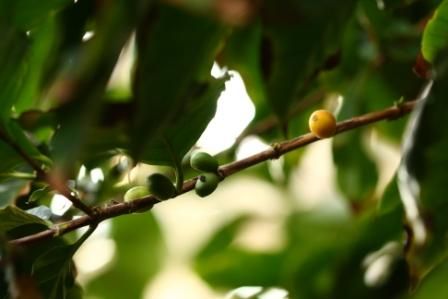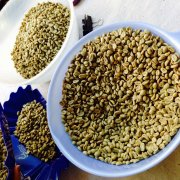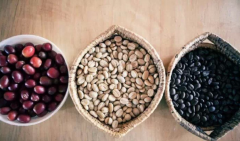Coffee tree planting conditions what conditions do coffee trees need to grow?

Coffee is a perennial evergreen shrub or small tree of Rubiaceae. It is a horticultural perennial cash crop with the characteristics of fast growth, high yield, high value and wide market. Wild coffee trees can grow to a height of 5 to 10 meters, but coffee trees planted on the manor are often cut to a height of less than 2 meters in order to increase the amount of fruit and facilitate harvesting. Coffee tree opposite leaves are long oval, smooth leaves, the end of the branch is very long, few branches, and the flowers are white, open at the base of the petiole connecting the branch. The ripe coffee berries look like cherries and are bright red with sweet flesh and contain a pair of seeds, namely coffee beans (Coffee Beans). Coffee varieties can be divided into small-grain, medium-grain and large-grain species, the former contains low caffeine content and strong flavor, while the latter two have high caffeine content but poor flavor. At present, coffee sold in the world is generally made of small and medium seeds in different proportions, usually 70% of medium seeds, mainly caffeine, and 30% of small seeds, mainly for their aroma. Each coffee variety generally has a few to a dozen variants. Coffee is more resistant to shade and cold, but not resistant to light, drought and disease. Coffee contains nine kinds of nutrients, such as caffeine, protein, crude fat, crude fiber and sucrose. As a beverage, coffee is not only mellow and delicious, slightly bitter and sweet, but also can excite nerves and dispel fatigue. In medicine, caffeine can be used as an anesthetic, stimulant, diuretic and cardiotonic, as well as to help digestion and promote metabolism. The pulp of coffee is rich in sugar and can be used to make sugar and alcohol. Coffee flowers contain essential oils that can be used to extract high-grade spices.
Planting conditions of Coffee trees
The origin of the coffee tree is Ethiopia in Africa. In botany, coffee trees belong to the evergreen trees of the subgenus Rubiaceae, and coffee beans, commonly known as coffee beans, are the seeds of the fruit of coffee trees, just because they are shaped like beans, so they are called coffee beans.
Climate is the decisive factor for coffee cultivation. Coffee trees are only suitable for growing in the tropics or subtropics, so the zone between latitude 25 degrees south and north is the most suitable for growing coffee. This coffee production zone is generally referred to as "coffee belt" or "coffee area".
However, not all the land located in this area can cultivate good coffee trees. The ideal planting conditions for coffee trees are: a warm climate with a temperature of 15-25 ℃, and a rainfall of 1500-2000 mm throughout the year, and the rainfall time should be consistent with the flowering cycle of the coffee tree. Of course, in addition to the coordination of seasons and rainfall, there should be fertile soil. The most suitable soil for growing coffee is a well-drained, fertile soil containing volcanic ash.
In addition, although sunlight is an indispensable element for the growth and fruiting of coffee, too strong sunlight will affect the growth of coffee trees, so various producing areas will usually cooperate with the planting of some sunshade trees. generally plant higher trunk plants such as bananas, mangoes and legumes. The ideal altitude is 500-2000 meters above sea level. Therefore, the quality of Jamaican Blue Mountain coffee, which grows at an altitude of 8-1200 meters, is the best. It can be seen that the conditions for the cultivation of high-quality coffee are very strict: sunlight, rainfall, soil, air temperature, as well as the way coffee beans are harvested and the production process will affect the quality of coffee itself.
Flower and fruit
The first flowering period of the coffee tree is about three years old. the white five-petal tube-shaped flowers are filled with a faint scent of jasmine and the inflorescences are arranged in dense clusters. Flowers wither after two or three days of blooming and begin to bear fruit after a few months. The fruit is a drupe with a diameter of about 1.5cm. It turns green at first, then turns yellow gradually, and turns red when ripe. It is very similar to cherries, so it is called cherry coffee (Coffee Cherry). It can be harvested at this time.
Coffee fruit contains two seeds, namely coffee beans. The two beans are connected face to face with each other on one side of the plane. Each coffee bean has an outer membrane of pu, which is called silver skin, and its outer layer is covered with a yellow outer skin, called endocarp. The whole coffee bean is wrapped in a sticky pulp to form the coffee pulp, which is soft and sweet, with the outer shell.
Important Notice :
前街咖啡 FrontStreet Coffee has moved to new addredd:
FrontStreet Coffee Address: 315,Donghua East Road,GuangZhou
Tel:020 38364473
- Prev

Correctly planting Coffee Tree Coffee Tree growth process Map
One of the characteristics of a coffee tree is that its fruit can bear fruit several times a year, and another is that flowers and fruits coexist at different stages of ripening. If the fruit is too ripe, the beans in it will rot. If the beans are not ripe, the beans will not ripen by themselves. So bean pickers often go through the same tree several times to find ripe fruit, but try their best.
- Next

Where is it suitable for growing Coffee in China? performance of brewing flavor of small-grain coffee in Baoshan, Yunnan, China
Coffee has been grown in China for more than one hundred years, but it has not been long since it became a commodity. In the late 1980s, the area was as high as 270000 mu, including 210000 mu in Hainan, 50, 000 mu in Yunnan and more than 10, 000 mu in Guangdong, and some were planted in Fujian. Later, as the price of coffee beans fell, the growers had to change the coffee to other crops. The acreage began to decline in 1991
Related
- Beginners will see the "Coffee pull flower" guide!
- What is the difference between ice blog purified milk and ordinary milk coffee?
- Why is the Philippines the largest producer of crops in Liberia?
- For coffee extraction, should the fine powder be retained?
- How does extracted espresso fill pressed powder? How much strength does it take to press the powder?
- How to make jasmine cold extract coffee? Is the jasmine + latte good?
- Will this little toy really make the coffee taste better? How does Lily Drip affect coffee extraction?
- Will the action of slapping the filter cup also affect coffee extraction?
- What's the difference between powder-to-water ratio and powder-to-liquid ratio?
- What is the Ethiopian local species? What does it have to do with Heirloom native species?

